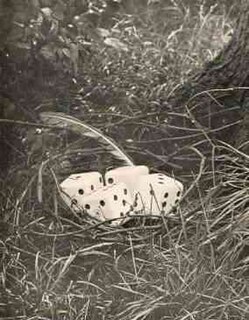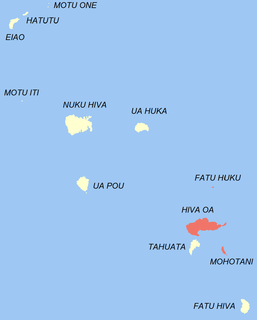
The Marquesas Islands are a group of volcanic islands in French Polynesia, an overseas collectivity of France in the southern Pacific Ocean. The Marquesas are located at 9.7812° S, 139.0817° W. The highest point is the peak of Mount Oave on Ua Pou island at 1,230 m (4,035 ft) above sea level.
In Polynesian mythology, Hawaiki is the original home of the Polynesians, before dispersal across Polynesia. It also features as the underworld in many Māori stories.

Fatu-Hiva is the southernmost island of the Marquesas Islands, in French Polynesia, an overseas territory of France in the Pacific Ocean. With Motu Nao as its closest neighbor, it is also the most isolated of the inhabited islands.

With its 320 square kilometres, Hiva Oa is the second largest island in the Marquesas Islands, in French Polynesia, an overseas territory of France in the Pacific Ocean. Located at 9 45' south latitude and 139 W longitude, it is the largest island of the southern Marquesas group. Around 2,200 people reside on the island. A volcano, Temetiu, is Hiva Oa's highest point with 1,200 metres.

Fatu Huku, also known as Fatu Uku, is a small island in the Marquesas Islands, approximately 30 kilometres (19 mi) north of Hiva Oa. Fatu Huku is less than 2 kilometres (1.2 mi) long and 1 kilometre (0.62 mi) wide and has an area of about 1.3 square kilometres (0.50 sq mi)

Hana Vave is the name of the northernmost bay on the west coast of Fatu Hiva in French Polynesia. The bay is sometimes called the Bay of Virgins, a translation of the French name Baie des Vierges.

Fatu-Hiva - Back to Nature is a book published in 1974 by archaeologist and explorer Thor Heyerdahl detailing his experiences and reflections during a 15-month stay on the Marquesan island of Fatu Hiva in 1937–38. The book was based on Heyerdahl's original report På Jakt efter Paradiset, which was published in Norway in 1938, but because of the outbreak of World War II was never translated and rather forgotten.

Omo‘a is the name of a small town and valley at the head of a bay by the same name, on Fatu Hiva.
The Fatu Hiva monarch is a large flycatcher in the family Monarchidae. It is endemic to Fatu Hiva in the Marquesas Islands, French Polynesia. It lives in the native dense forest at elevations up to 2300 feet. Adults are a glossy purplish-black with plush-like feathers on their foreheads and grow to around 7 ½ inches.

The ultramarine lorikeet is a species of parrot in the family Psittaculidae, endemic to the Marquesas Islands. Its natural habitats are subtropical or tropical moist lowland forest, subtropical or tropical moist montane forest and plantations. It is threatened mainly by introduction of the black rat and also by deforestation.

Pomarea is a genus of birds in the monarch flycatcher family Monarchidae. The genus is restricted to the islands of Polynesia. The monarchs of this genus are around 15–19 cm long and most have sexually dimorphic plumage.
Phyllanthus marchionicus is a species of tree in the family Phyllanthaceae. It is endemic to the Marquesas Islands in French Polynesia, where it grows on the islands of Nuku Hiva, Ua Pou, Ua Huka, Hiva Oa, Tahuata, and Fatu Hiva, in a variety of habitats.

The Fatu-liva is a fictional species of bird invented by George S. Chappell in his travel parody The Cruise of the Kawa: Wanderings in the South Seas, by Walter E. Traprock (1921). Fatu-liva were said to be found only in the fictional "Filbert Islands" in the South Pacific Ocean where they laid cube-like, black-spotted eggs that were very similar in appearance to dice. The bird's nest was described in the book as:
"...a semi-spheric bowl of closely woven grass in which lay four snow-white, polka-dotted cubes, the marvelous square eggs of the fatu-liva."
The Marquesas Islands are the island group farthest from any continent in the world, lying between 400 and 600 miles south of the equator and approximately 1,000 miles (1,600 km) northeast of Tahiti. They fall naturally into two geographical divisions: the northern group, consisting of Eïao, Hatutu (Hatutaa), Motu One, and the islands centered on the large island of Nuku Hiva: Motu Iti, Ua Pou, Motu Oa and Ua Huka, and the southern group of Fatu Uku, Tahuata, Moho Tani (Motane), Terihi, Fatu Hiva and Motu Nao, clustered around the main island of Hiva `Oa.

Hiva-Oa is a commune of French Polynesia, an overseas territory of France in the Pacific Ocean. The commune is in the administrative subdivision of the Marquesas Islands. Its population was 2,243 at the 2017 census.

Nuku Hiva is the largest of the Marquesas Islands in French Polynesia, an overseas country of France in the Pacific Ocean. It was formerly also known as Île Marchand and Madison Island.
The French Polynesia 's 2nd constituency is a French legislative constituency in French Polynesia. It is currently represented by Nicole Sanquer of Tahoera'a Huiraatira.
This page is based on this
Wikipedia article Text is available under the
CC BY-SA 4.0 license; additional terms may apply.
Images, videos and audio are available under their respective licenses.











